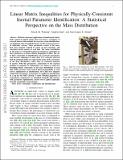Linear Matrix Inequalities for Physically Consistent Inertial Parameter Identification: A Statistical Perspective on the Mass Distribution
Author(s)
Wensing, Patrick M.; Kim, Sangbae; Slotine, Jean-Jacques E
Download1701.04395.pdf (3.585Mb)
OPEN_ACCESS_POLICY
Open Access Policy
Creative Commons Attribution-Noncommercial-Share Alike
Terms of use
Metadata
Show full item recordAbstract
With the increased application of model-based whole-body control in legged robots, there has been a resurgence of research interest into methods for accurate system identification. An important class of methods focuses on the inertialparameters of rigid-body systems. These parameters consist of the mass, first mass moment (related to center of mass location), and rotational inertia matrix of each link. The main contribution of this letter is to formulate physical-consistency constraints on these parameters as Linear Matrix Inequalities (LMIs). The use of these constraints in identification can accelerate convergence and increase robustness to noisy data. It is critically observed that the proposed LMIs are expressed in terms of the covariance of the mass distribution, rather than its rotational moments of inertia. With this perspective, connections to the classical problem of moments in mathematics are shown to yield new bounding-volume constraints on the mass distribution of each link. While previous work ensured physical plausibility or used convex optimization in identification, the LMIs here uniquely enable both advantages. Constraints are applied to identification of a leg for the MIT Cheetah 3 robot. Detailed properties of transmission components are identified alongside link inertias, with parameter optimization carried out to global optimality through semidefinite programming.
Date issued
2017-07Department
Massachusetts Institute of Technology. Department of Mechanical EngineeringJournal
IEEE Robotics and Automation Letters
Publisher
Institute of Electrical and Electronics Engineers (IEEE)
Citation
Wensing, Patrick M., Sangbae Kim, and Jean-Jacques E. Slotine. “Linear Matrix Inequalities for Physically Consistent Inertial Parameter Identification: A Statistical Perspective on the Mass Distribution.” IEEE Robotics and Automation Letters 3, no. 1 (January 2018): 60–67.
Version: Original manuscript
ISSN
2377-3766
2377-3774